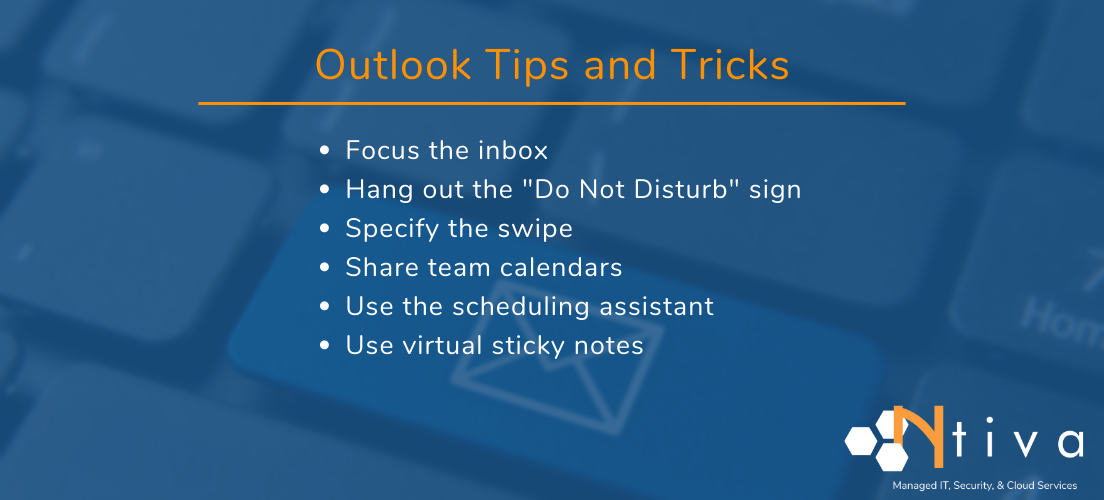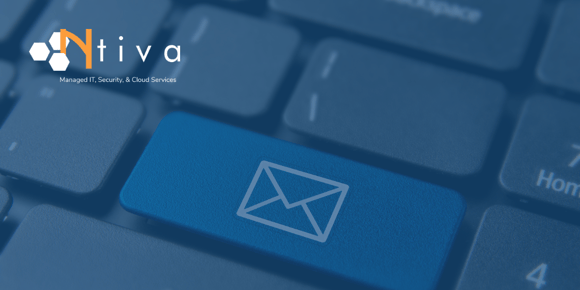If you want to help your office and remote employees be more productive across time zones or across town, one of the first places you should start is with Microsoft 365 in general, and with Outlook in particular.
Outlook is the application that integrates email, calendar and contacts to help your workers stay connected and productive, both in the office and on the go. Here are the top ways to help your staff tame their inbox and organize their calendar, so they can stay on top of their tasks.
Master the Inbox
Outlook is best known as an email application used by millions of people, but it’s now more accessible than ever, with intuitive, voice-controlled navigation, support for multiple assistive devices, and more.
Here are 6 tips to show you how to get the most out of your Outlook Email and Calendar!

1. Focus the inbox
According to Harvard Business Review, most business professionals have more than 200 email messages in Outlook, and they receive a further 120 new emails in Outlook each day. Full inboxes waste a lot of time (roughly 27 minutes a day) as workers read and re-read the same subject lines and preview text every time they scan their inbox.
One solution to inbox clutter is to focus the inbox. Users essentially create two inboxes. One is Focused and the other is Other. Then they toggle between the two inboxes by sliding a button at the top of their Outlook inbox.
When the slider is set on Focused, Outlook sorts all incoming email. It moves clearly important messages to the Focused inbox and moves clearly unimportant messages (junk mail, anyone?) to the Other inbox.
Focused Inbox uses artificial intelligence and machine learning to discover what is important and what is not, based on user behavior. The more that a worker uses the Focused Inbox feature, the smarter it gets. Focused inbox pays attention to how employees open, read and sort messages, and in the process gets smarter at classifying incoming messages.
Focused Inbox is also teachable. Workers can select “Always Move to Focused” or “Always Move to Other” so that all messages always go the desired inbox. Focused Inbox helps workers save time by not having to wade through trivial emails.
2. Hang out the “Do Not Disturb” sign
Endlessly checking email is distracting and a waste of precious time. It takes workers away from the task at hand, and often interrupts projects when workers stop what they are doing to respond to messages that can otherwise wait.
If you want your workers to stay on task and avoid distractions, encourage them to use the “Do Not Disturb feature” in Outlook. Do Not Disturb disables all default Outlook notifications, namely:
· new messages
· new mail desktop alerts
· the envelope icon in the system tray
· the default new mail sound
One nice feature of Do Not Disturb is that your workers can schedule it to automatically come on during specific times of the day when they cannot afford to be disturbed or distracted. They can also turn it on manually and set a timer that returns Outlook notifications to default operation after a set amount of time.
3. Specify the swipe
Another great productivity hack with Outlook on mobile devices is creating custom swipe actions. It’s like Tinder for email. Your workers go into their settings and tell Outlook what they want to happen when they swipe left or right on a message in their inbox. There are five available actions:
- Delete
- Mark as Read
- Mark as Unread
- Flag
- Archive
Customized swiping actions saves a lot of time and helps workers sort through their messages on tablets and phones quickly and easily.
Related Reading: 21 Powerful Microsoft Teams Tips and Tricks Popular With Experts
Conquer the Calendar
What’s worse than wasting your time in a meeting? Wasting everyone’s time by forgetting the meeting. Outlook Calendar helps your employees and team members stay organized by scheduling all their work activities in one place. Here are some ways to help you stay on top of your calendar.
4. Share team calendars
The first productivity hack for getting more from Outlook Calendar is to share team calendars. When everyone on a team shares their Outlook Calendar with every other member of the team, planning projects and scheduling team and individual meetings gets a whole lot easier.
Outlook lets workers see all calendars on one screen, showing who is available and who is busy on any given day and at any given hour. Sharing calendars saves time and boosts productivity, especially when scheduling meetings that require more than two people to attend. Your workers eliminate the wasted time spent emailing back-and-forth to discover the perfect date and time for all.
Being able to share calendars requires that your Outlook installation is configured properly on the back end. This is one occasion where you may need to hire a Microsoft 365 Consultant.
5. Use the Scheduling Assistant
The easiest way to avoid the cumbersome back and forth of scheduling meetings is to use Outlook’s built-in Scheduling Assistant. Your worker simply creates an event on their calendar and adds the people that are invited to attend.
Times in which attendees are unavailable appear on the calendar in dark blue. Times in which your attendees have a tentative appointment appear in a light-blue, hashed block. And times outside of the attendees' working hours appear in light gray.
All other spots on the calendar appear in white and indicate the attendee is available. Your worker simply selects a time that suits all attendees and drags the meeting invitation to that slot in the calendar. Done and dusted.
6. Use virtual sticky notes
Some tasks are too important to leave to memory but not important enough to place on a calendar. The easiest way to remember these to-do items is with Outlook’s notes feature.
All your worker does is use the Ctrl + Shift + N keyboard shortcut in Outlook. That creates a new, untitled note. Your worker gives the note a title, or just types a task into the note, then drags the note to a prominent spot on their screen where they won’t overlook it.
Once they have completed the task, they delete it. This is a great productivity hack for busy employees who need to remind themselves of small tasks that don’t necessarily require a full-blown meeting or an entry into your task management system.
Microsoft 365 Tips for Greater Productivity and Efficiency
Staying productive in the office and on the go is a lot easier once your employees take advantage of the productivity features in Outlook.
One essential of getting the most out of Outlook is getting the most out of Microsoft 365 (formerly Microsoft Office 365). This is why Ntiva offers a suite of Microsoft 365 services, consulting and training solutions to companies like yours. If we can be of service, let us know.




